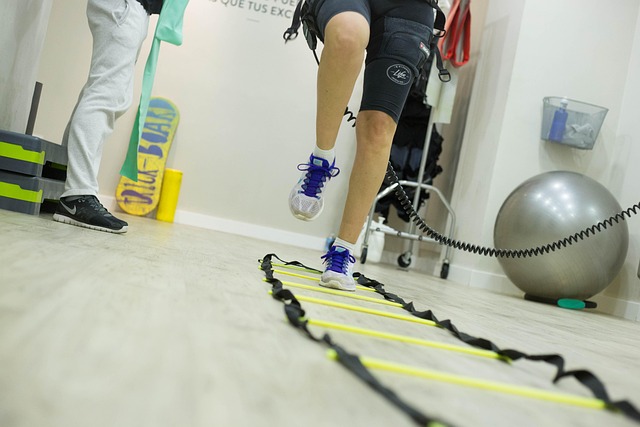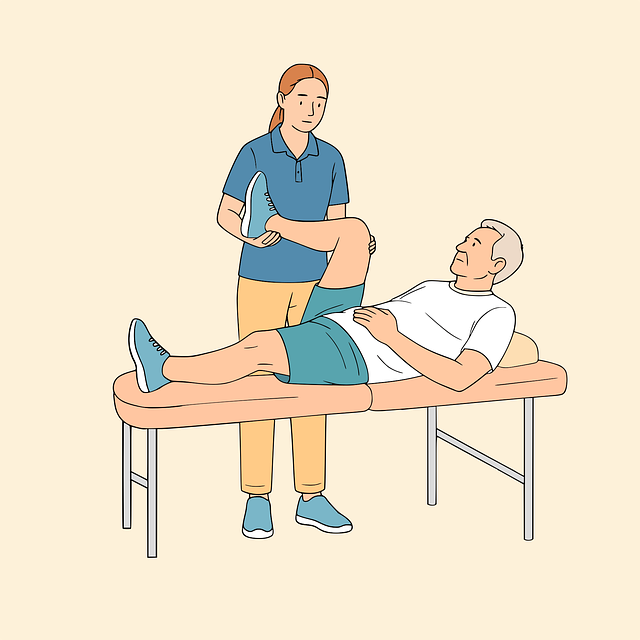Resistance training, vital for all ages, strengthens muscles, improves fitness, bone density, and joint health. Personalized plans, focusing on compound movements and progressive overload, should include both overall strength exercises and specific muscle group isolation. Consistency (2-3 weekly sessions) with tracking progress via workout logging is key. Beginners start with bodyweight exercises, progressing to weights; advanced individuals can incorporate interval training or drop sets. Accessible at-home variations cater to all fitness levels, enhancing wellness journeys.
Looking to elevate your wellness routine? Consider incorporating resistance training plans. This powerful tool goes beyond building muscle; it enhances overall fitness, boosts metabolism, and improves bone density. Our guide breaks down everything you need to know, from understanding the benefits and key concepts of resistance training to designing a personalized plan and tracking your progress. Discover how to seamlessly integrate these effective exercises into your daily routine for optimal wellness.
- Understanding Resistance Training: Benefits and Key Concepts
- Designing a Comprehensive Resistance Training Plan
- Incorporating Resistance Training into Daily Routine
- Tracking Progress and Adjusting Your Resistance Training Plans
Understanding Resistance Training: Benefits and Key Concepts

Resistance training, a cornerstone of any robust wellness plan, involves exercises that build muscle strength and endurance by putting stress on the body. This type of training isn’t just for athletes; it’s an effective way to improve overall fitness, bone density, and joint health, making it relevant for folks of all ages and activity levels. The benefits are wide-ranging, from enhancing physical appearance and boosting metabolism to improving athletic performance and preventing injury.
Key concepts in resistance training include progressive overload – gradually increasing the intensity or volume of workouts to continue challenging your body – and variety. Incorporating different types of exercises, such as weightlifting, bodyweight exercises, and using resistance bands, not only targets various muscle groups but also prevents boredom and reduces the risk of overuse injuries. When structuring resistance training plans, focus on compound movements that work multiple muscles at once, ensuring a well-rounded and efficient workout routine.
Designing a Comprehensive Resistance Training Plan

Designing a comprehensive resistance training plan involves several key components that cater to individual wellness goals and fitness levels. Start by assessing your current physical condition, considering factors like age, health history, and existing strength levels. This foundation allows for tailoring exercises and intensity to ensure safety and effectiveness. Incorporate a mix of compound movements, such as squats, deadlifts, and bench presses, which target multiple muscle groups, enhancing overall strength and stability.
Complement these with isolation exercises to strengthen specific areas, like biceps or triceps. Include progressive overload principles by gradually increasing weights or reps over time to continue challenging your body. Flexibility and mobility exercises should also be integrated to prevent injury and improve range of motion. A well-rounded resistance training plan should be consistent yet adaptable, allowing for adjustments as you progress through different phases of wellness and fitness journeys.
Incorporating Resistance Training into Daily Routine

Incorporating resistance training into your daily wellness routine can be a game-changer for overall fitness and health. It’s not just about building muscles; resistance exercises enhance bone density, improve cardiovascular health, and boost metabolism. Starting with simple bodyweight exercises like push-ups, squats, or lunges is an excellent way to introduce resistance training. Over time, you can progress to using free weights, resistance bands, or machines for more intense workouts. Consistency is key; aim for 2-3 sessions per week, allowing adequate rest and recovery between workouts.
Designing a resistance training plan involves considering your fitness level, goals, and available equipment. For beginners, focus on learning proper form and gradually increasing the weight or intensity. More advanced individuals can incorporate interval training, supersets, or drop sets to challenge their bodies further. Incorporating resistance training into your routine doesn’t have to be complex; simple variations of exercises can be done at home with minimal equipment, making it accessible for everyone to enhance their wellness journey.
Tracking Progress and Adjusting Your Resistance Training Plans

Tracking progress is a vital component of any successful resistance training plan. Regularly record your workouts, noting the weight lifted, sets completed, and repetitions achieved. This data allows for clear visualization of strength gains and stamina improvements over time. By comparing your initial benchmarks to subsequent performances, you can objectively assess your progress and make informed decisions regarding your training intensity and frequency.
Adjustments are inevitable as you advance in your fitness journey. If you consistently reach plateaus or experience reduced performance, consider tweaking your resistance training plans. This might involve increasing the weight, adding new exercises, or altering your rest periods. Stay adaptable, listen to your body, and be open to refining your approach to ensure continuous challenges that propel you toward your wellness goals.
Resistance training is a versatile and powerful tool for enhancing overall wellness. By understanding its benefits, designing tailored plans, and seamlessly integrating it into daily routines, individuals can achieve remarkable results. Whether focusing on strength, endurance, or body composition, these structured plans offer a sustainable path to success. Regular tracking and adjustments ensure continued progress, making resistance training a valuable asset in any wellness journey. Incorporating these strategies, you’ll unlock your full potential and create lasting, positive changes through effective resistance training plans.
